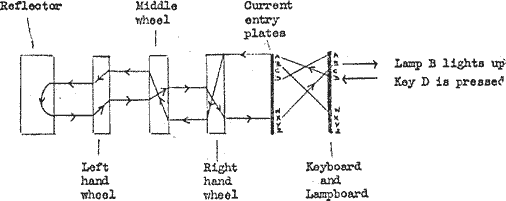Cryptographic History of Work on the German Naval Enigma
Encoding a Letter
3. The machine works as follows. (1) Each wheel has on one side a single set of 26 pin contacts and on the other side 26 flat contacts, these two sets of contacts are wired to each other. The reflector has 26 pin contacts wired to each other. (2) When a key is pressed the current enters the machine at a current entry plate (i.e. one of the 26 contacts on the current entry disc) goes through the three wheels to the reflector, then comes back through the three wheels to the current entry plate and thence to the lampboard on which a light then shows up. (3) The Stecker plugs connect the keyboard and lampboard to the current entry plate, the connections being reciprocal i.e. if A and G are connected by a Stecker plug then the connections AG and GA are made both between keyboard and the entry disc and also between current entry disc and lampboard. (4) When a key is pressed the turnover pawl engages in the rim of the wheel next to the current entry plate and turns the wheel over one place, so that if the same letter were again encoded the path travelled by the current through the machine would be a different one.
4. A rough diagram will show how this works (in practice of course the wheels are in contact with each other).

Diagram 2. Encoding a letter on the machine.
In this example the steckers B to X (written B/X) and A/D have been put in.
The "Reciprocal" and "Non-crashing" Properties.
5. If instead of encoding D (and getting B) as in this example, we had encoded B then we should have got D; for the path traced by the current would have been exactly the same only in the opposite direction. This is an example of the general law that if (say) X encodes as Y then at the same
-2-
Back to Cryptographic History of Work on the German Naval Enigma contents